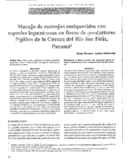Mostrar el registro sencillo del ítem
Manejo de rastrojos enriquecidos con especies leguminosas en fincas de productores Ngöbes de la cuenca del río San Félix, Panamá
| dc.contributor.author | Moreno, Tomás | es_ES |
| dc.contributor.author | Schlonvoigt, Andrea | es_ES |
| dc.date.accessioned | 2015-03-19T21:51:45Z | |
| dc.date.available | 2015-03-19T21:51:45Z | |
| dc.date.issued | 2002 | |
| dc.identifier | 466361 | es_ES |
| dc.identifier.issn | 1022-7482 | es_ES |
| dc.identifier.uri | https://repositorio.catie.ac.cr/handle/11554/6544 | |
| dc.description | 1 ilus. 5 tab. 21 ref. 7 pág. | es_ES |
| dc.description.abstract | Se evaluó el potencial de diferentes especies leguminosas en sistemas de barbechos mejorados en la Cuenca Media-Baja del Río San Félix, Panamá. Canavalia ensiformis presentó la mayor sobrevivencia a un mes de ser plantado (93 por ciento), seguido de Mucuna pruriens (83 por ciento), Purearia phaseoloides (54 por ciento) y Cajanus cajan (51 por ciento). M. pruriens presentó mayor cobertura (58 por ciento), seguido de C. ensiformis (14 por ciento), C. cajan (1 por ciento) y P. phaseoloides (menor que 1 por ciento). M. pruriens también presentó la mayor producción de biomasa fresca (4,4 t ha-1), seguida de C. ensiformis (2,2 t ha-1), C. cajan (0,1 t ha-1) y P. phaseoloides (0,1 t ha-1). Los barbechos con C. ensiformis y M. pruriens presentaron las mayores producciones de biomasa fresca total (17,2 y 15,3 t ha-1, respectivamente). C. cajan presentó la mayor concentración de N en su biomasa (2,7 por ciento), seguido de M. pruriens (2,6 por ciento), C. ensiformis (2,4 por ciento) y P. phaseoloides (2,0 por ciento). Sin embargo, tomando en cuenta la producción de biomasa, M. pruriens acumuló la mayor cantidad de N (19,2 kg ha-1), seguido de C. ensiformis (10,6 kg ha-1), C. cajan (0,8 kg ha-1) y P. phaseoloides (0,2 kg ha-1) a tres meses de edad. Todos los productores participantes mostraron preferencia por M. pruriens como especie con mayor potencial para ser utilizada en barbechos mejorados en la zona (65 por ciento de aceptabilidad por parte de los productores). The potential of different leguminous plant species as cover crops to improve fallow systems was evaluated in the central low watershed of the San Felix River, Panama. Canavalia ensiformis had the highest survival (93 percent), followed by Mucuna pruriens (83 percent), Pueraria phaseoloides (54 percent) and Cajanus cajan (51 percent). M. pruriens gave the highest ground cover (58 percent), followed by C. ensiformis (14 percent), C. cajan (1 percent) and P. phaseoloides (minor who 1 percent). M. pruriens also produced the highest amount of fresh biomass (4.44 t ha-1), followed by C. ensiformis (2.17 t ha-1), C Cajan (0.13 t ha-1) and P. phaseoloides (0.06 t ha-1). The fallow treatment with C. ensiformis had the highest total biomass production (17.2 t ha-1), followed by M pruriens (15.3 t ha-1). C. Cajan had the highest N concentration in its biomass (2.7 percent), followed by M. pruriens (2.6 percent), C enfiormis (2.4 percent) and P. phaseoloides (2.0 percent). However, taking into acount biomass production, M. pruriens accumulated the highest amount of N (19.2 kg ha-1), followed by C. ensiformis (10,6 kg ha-1), C. cajan (0.8 kg ha-1) and P. phseoloides (0.2 kg ha-1) at age three months. All the farmers who participated in this study preferred M. pruriens as the best potential species to improve fallows in the study region (probability of acceptability fo 65 percent). | es_ES |
| dc.language.iso | es | es_ES |
| dc.publisher | CATIE, Turrialba (Costa Rica) | es_ES |
| dc.relation.ispartof | Agroforestería en las Américas v. 9 n. 35-36 p. 22-28 | |
| dc.subject | MUCUNA PRURIENS | es_ES |
| dc.subject | PUERARIA PHASEOLOIDES | es_ES |
| dc.subject | CAJANUS ENSIFORMIS | es_ES |
| dc.subject | LEGUMINOSAS | es_ES |
| dc.subject | ABONOS VERDES | es_ES |
| dc.subject | RESIDUOS DE COSECHAS | es_ES |
| dc.subject | BARBECHO | es_ES |
| dc.subject | BIOMASA | es_ES |
| dc.subject | MATERIA ORGANICA | es_ES |
| dc.subject | PANAMA | es_ES |
| dc.title | Manejo de rastrojos enriquecidos con especies leguminosas en fincas de productores Ngöbes de la cuenca del río San Félix, Panamá | es_ES |
| dc.title.alternative | Management of fallows enriched with leguminous species on farms of Ngöbe farmers in the watershed of San Félix River, Panamá | es_ES |
| dc.type | Artículo | es_ES |
| dc.journal.issueNumber | 35-36 |


